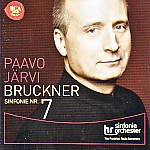Bruckner recordings are still coming fast and furious (that is, the rate of release, not tempo of performance necessarily). Paavo Järvi clearly has a vision about how he wants the music to sound. Just listen to something as simple as his handling of the tremolos beneath the symphony’s opening theme. However, these little touches don’t quite add up to a coherent listening experience. This is most obvious in the outer movements, where Järvi sectionalizes each thematic group to the point where the music becomes a random assemblage of unrelated sound-blocks. And let’s face it, if there’s anything Bruckner doesn’t need it’s to sound even more discontinuous than the music already is. Just check out the opening two subjects as compared with the dance-like third theme, here surely taken too quickly given the context. Then listen to how Järvi slows down for the coda, turning it into a totally separate episode. All of this can be handled with much more subtlety, as in the two listed reference recordings.
The same lack of flow typifies the finale. Why such heaviness at those brassy eruptions of the main theme in the development section? The scherzo and adagio, though, don’t present anything like the same interpretive challenges. Järvi includes the percussion at the climax of the latter, but the brass playing is oddly unbalanced (or overly blended, depending on your perspective), with curiously reticent trumpets. This is a pity: they have the tune and we should hear them.
The SACD multichannel sonics are good, but not great by any measure. At climaxes the sound may strike you as somewhat harsh at the upper end, but less than ideally clear at the same time. In short, this isn’t quite a fully formed interpretation from a conductor with enough ideas to make us want to hear what he may have to say in this music on further reflection. But that’s a matter for the future.
































